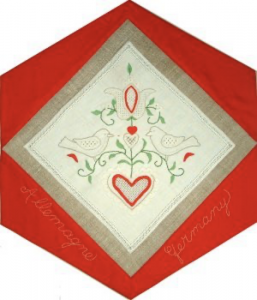Germany

The Block
The Germany block is a wonderful example of Schwalm, a form of drawn-thread embroidery, which originated in a small region of Hesse known as ‘The Schwalm’. This style of needlework, expertly done by Elfriede Petric, incorporates both counted and non-counted thread techniques. It is customarily done in white on white, however Elfriede included colours to visually enhance her design. The doves, heart and tulip are but three of the traditional motifs that have become an integral part of Germanic folk tradition. Found extensively on furniture and clothing, these motifs are also evident in paintings and Fraktur, a treasured art form practiced by the Pennsylvania Dutch communities of southern Ontario that combines calligraphic and pictorial elements. Pulled thread, a technique in which certain tightly pulled stitches are used to form patterns of holes in the fabric, frames the linen woven by the block-maker’s grandfather. The backing fabric, estimated to be over 200 years old, came from flax that was grown, processed and woven on a farm in the Crysler Park area of Morrisburg, Ontario.
Cultural Profile
Germany, a western European country, has made a lasting and staggering imprint on world culture. It is the birthplace of Bach, Beethoven, Schumann, Brahms and Wagner; a country in which music has long been a tradition and where more than 100 music festivals are celebrated annually. Its contribution to literature is also vital, with authors like Goethe, Schiller, Hermann Hesse, Thomas Mann and the Brothers Grimm. Philosophers such as Leibniz, Kant, Schopenhauer, Marx, Nietzsche, Hegel and Heidegger have all shaped modern philosophy. The capital, Berlin, has the reputation of being one of the most avant-garde places for the arts.
The official language is German, though almost half of all the population also speaks English fluently. In the past, Germans were known for their industriousness and for taking their work very seriously, but this approach has been moderated more recently with a more relaxed lifestyle where family, friendships and leisure are high priorities.
Germans are also known for their folk customs and art, and the continuity of these cultural traditions which vary from region to region, is important to them. Each region has its tracht, its traditional costume that showcases textile arts specific to one region. For example, the area of Spreewald is known for its embroidery featured on the coif, skirt and blouse. Resist-dyeing with indigo pigment, Blaudruck, is done in Lower Saxony and produces deep blue textiles with white motifs. The area of Erzgebirge, bordering the Czech Republic, is known for its bobbin lace making tradition. The Black Forest is known for the black dresses, white blouses and red pompom hats worn during traditional events. More generally, the dirndl, the dress traditionally associated with servant girls, and lederhosen, the leather pants worn by men, are popular costumes worn on German festive occasions such as Oktoberfest. Germans are also known for their glass and porcelain objects, their clocks (especially the cuckoo clocks of the Black Forest), wood carvings, and automotive industry.
The German presence in Canada was first recognized in 1664 when Hans Bernhard bought land in Québec City. Since then, many thousands of Germans have come to Canada, settling initially in Nova Scotia, Ontario and New Brunswick. In the early 1750s, they were known as expert fishermen and boat-builders renowned for building the ‘Bluenose’ schooner that is depicted on the Canadian dime. Later German settlers expanded into the western provinces where they have made an indelible imprint. For example, half of the people living in Saskatchewan today have claimed to be of German ancestry.
Since the beginning of their settlement, Germans, as artisans, engineers, manufacturers, entrepreneurs, professionals and artists, contributed much to the growth and development of Canada. There are currently numerous German communities across the country, with over 3,000,000 Canadians declaring to be of German ancestry. Their culture has influenced many Canadian celebrations, including Christmas. Indeed, the Christmas tree tradition is believed to have originated in Germany, and Oktoberfest is now celebrated in communities across Canada.
Sponsor: Christine Allan, Ruth Friedrich
